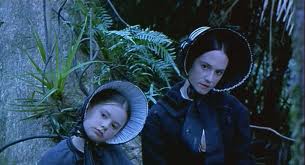This Jane Campion movie is about a mute widow and her daughter in the 19th century, who are forced to move to New Zealand thanks to an arranged marriage. Although the main character is unable to speak, the cinematography and mise-en-scene are rich enough to add much information to the story so that the audience is taken along the ride without any sense of deprivation.
Like these still shots suggest, The Piano is full of long shots and extreme long shots to show the vastness of the landscapes, signifying isolation as well as possiblility. Many times, it is also used to highlight the sense of smallness that the character may be feeling at the moment. Deep and shallow focus is also used to emphasize these themes. The colors remain dark and bleak throughout the film, which reflects Campion's American Gothic influences.
Light plays a big part in creating intimacy and is used to contrast the coldness of the outside world. We see warm colors and light mostly in Baine's house and when Ada and her daughter are talking to each other, usually before bedtime. Unfortunately, I can't find the pictures of the pretty amber light shown when the mother and daughter are together...




No comments:
Post a Comment